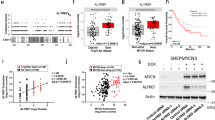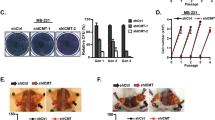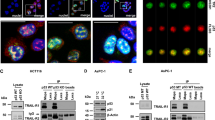Abstract
The occurrence of pathologically stable mRNAs of proto-oncogenes, growth factors and cyclins has been proposed to contribute to experimental and human oncogenesis. In normal resting cells, mRNAs containing an AU-rich element (ARE) in their 3′ untranslated region are subjected to rapid degradation. Tristetraprolin (TTP) is an RNA-binding zinc-finger protein that promotes decay of ARE-containing mRNAs. Here we report that TTP acts as a potent tumor suppressor in a v-H-ras-dependent mast cell tumor model, where tumors express abnormally stable interleukin-3 (IL-3) mRNA as part of an oncogenic autocrine loop. Premalignant v-H-ras cells were transfected with TTP and injected into syngeneic mice. TTP expression delayed tumor progression by 4 weeks, and late appearing tumors escaped suppression by loss of TTP. When transfected into a fully established tumor line, TTP reduced cloning efficiency in vitro and growth of the inoculated cells in vivo. Transgenic TTP interfered with the autocrine loop by enhancing the degradation of IL-3 mRNA with concomitant reduction of IL-3 secretion. Our data establish the ARE as an antioncogenic target in a model situation, underline the importance of mRNA stabilization in oncogenesis and show for the first time that tumor suppression can be achieved by interfering with mRNA turnover.
This is a preview of subscription content, access via your institution
Access options
Subscribe to this journal
Receive 50 print issues and online access
$259.00 per year
only $5.18 per issue
Buy this article
- Purchase on Springer Link
- Instant access to full article PDF
Prices may be subject to local taxes which are calculated during checkout





Similar content being viewed by others
References
Aghib DF, Bishop JM, Ottolenghi S, Guerrasio A, Serra A and Saglio G . (1990). Oncogene, 5, 707–711.
Algate PA and McCubrey JA . (1993). Oncogene, 8, 1221–1232.
Banholzer R, Nair AP, Hirsch HH, Ming XF and Moroni C . (1997). Mol. Cell. Biol., 17, 3254–3260.
Carballo E, Cao H, Lai WS, Kennington EA, Campbell D and Blackshear PJ . (2001). J. Biol. Chem., 276, 42580–42587.
Carballo E, Lai WS and Blackshear PJ . (1998). Science, 281, 1001–1005.
Chen CY, Del Gatto-Konczak F, Wu Z and Karin M . (1998). Science, 280, 1945–1949.
Chen CY, Gherzi R, Ong SE, Chan EL, Raijmakers R, Pruijn GJ, Stoecklin G, Moroni C, Mann M and Karin M . (2001). Cell, 107, 451–464.
Chen C-YA and Shyu A-B . (1995). Trends Biochem. Sci., 20, 465–470.
Conne B, Stutz A and Vassalli JD . (2000). Nat. Med., 6, 637–641.
Diamantis ID, Nair AP, Hirsch HH and Moroni C . (1989). Proc. Natl. Acad. Sci. USA, 86, 9299–9303.
Dixon DA, Tolley ND, King PH, Nabors LB, McIntyre TM, Zimmerman GA and Prescott SM . (2001). J. Clin. Invest., 108, 1657–1665.
Eick D, Piechaczyk M, Henglein B, Blanchard JM, Traub B, Kofler E, Wiest S, Lenoir GM and Bornkamm GW . (1985). EMBO J., 4, 3717–3725.
Fan XC and Steitz JA . (1998). EMBO J., 17, 3448–3460.
Ford LP, Watson J, Keene JD and Wilusz J . (1999). Genes Dev., 13, 188–201.
Gao M, Wilusz CJ, Peltz SW and Wilusz J . (2001). EMBO J., 20, 1134–1143.
Gouble A, Grazide S, Meggetto F, Mercier P, Delsol G and Morello D . (2002). Cancer Res., 62, 1489–1495.
Hanahan D and Weinberg RA . (2000). Cell, 100, 57–70.
Hirsch HH, Backenstoss V and Moroni C . (1996). Growth Factors, 13, 99–110.
Hirsch HH, Nair AP, Backenstoss V and Moroni C . (1995). J. Biol. Chem., 270, 20629–20635.
Johnson BA, Geha M and Blackwell TK . (2000). Oncogene, 19, 1657–1664.
Keyomarsi K and Pardee AB . (1993). Proc. Natl. Acad. Sci. USA, 90, 1112–1116.
Knudson AG . (2000). Annu. Rev. Genet., 34, 1–19.
Lai WS, Carballo E, Strum JR, Kennington EA, Phillips RS and Blackshear PJ . (1999). Mol. Cell. Biol., 19, 4311–4323.
Lai WS, Carballo E, Thorn JM, Kennington EA and Blackshear PJ . (2000). J. Biol. Chem., 275, 17827–17837.
Lai WS, Stumpo DJ and Blackshear PJ . (1990). J. Biol. Chem., 265, 16556–16563.
Li J, Shen H, Himmel KL, Dupuy AJ, Largaespada DA, Nakamura T, Shaughnessy Jr JD, Jenkins NA and Copeland NG . (1999). Nat. Genet., 23, 348–353.
Loflin P, Chen CY and Shyu AB . (1999). Genes Dev., 13, 1884–1897.
Mahtani KR, Brook M, Dean JL, Sully G, Saklatvala J and Clark AR . (2001). Mol. Cell. Biol., 21, 6461–6469.
Ming XF, Kaiser M and Moroni C . (1998). EMBO J., 17, 6039–6048.
Ming XF, Stoecklin G, Lu M, Looser R and Moroni C . (2001). Mol. Cell. Biol., 21, 5778–5789.
Mukherjee D, Gao M, O'Connor JP, Raijmakers R, Pruijn G, Lutz CS and Wilusz J . (2002). EMBO J., 21, 165–174.
Nabors LB, Gillespie GY, Harkins L and King PH . (2001). Cancer Res., 61, 2154–2161.
Nair AP, Diamantis ID, Conscience JF, Kindler V, Hofer P and Moroni C . (1989). Mol. Cell. Biol., 9, 1183–1190.
Nair AP, Hahn S, Banholzer R, Hirsch HH and Moroni C . (1994). Nature, 369, 239–242.
Nair AP, Hirsch HH and Moroni C . (1992). Oncogene, 7, 1963–1972.
Peng SS, Chen CY, Xu N and Shyu AB . (1998). EMBO J., 17, 3461–3470.
Ross HJ, Sato N, Ueyama Y and Koeffler HP . (1991). Blood, 77, 1787–1795.
Schuler GD and Cole MD . (1988). Cell, 55, 1115–1122.
Stoecklin G, Colombi M, Raineri I, Leuenberger S, Mallaun M, Schmidlin M, Gross B, Lu M, Kitamura T and Moroni, C . (2002). EMBO J., 21, 4709–4718.
Stoecklin G, Ming XF, Looser R and Moroni C . (2000). Mol. Cell. Biol., 20, 3753–3763.
Stoecklin G, Stoeckle P, Lu M, Muehlemann O and Moroni C . (2001). RNA, 7, 1578–1588.
Winzen R, Kracht M, Ritter B, Wilhelm A, Chen CY, Shyu AB, Muller M, Gaestel M, Resch K and Holtmann H . (1999). EMBO J., 18, 4969–4680.
Wodnar-Filipowicz A, Heusser CH and Moroni C . (1989). Nature, 339, 150–152.
Worthington MT, Pelo JW, Sachedina MA, Applegate JL, Arseneau KO and Pizarro TT . (2002). J. Biol. Chem., 277, 48558–48564.
Acknowledgements
We thank Renate Looser, Marco Colombi and the late Beatrice Rickenbacher for technical assistance, Asha PK Nair for help with tumor cell transfection, and Ines Raineri for critical reading of the manuscript. This work was supported by Grant # 31-57065.99 from the Swiss National Science Foundation to C.M.
Author information
Authors and Affiliations
Corresponding author
Rights and permissions
About this article
Cite this article
Stoecklin, G., Gross, B., Ming, XF. et al. A novel mechanism of tumor suppression by destabilizing AU-rich growth factor mRNA. Oncogene 22, 3554–3561 (2003). https://doi.org/10.1038/sj.onc.1206418
Published:
Issue Date:
DOI: https://doi.org/10.1038/sj.onc.1206418
Keywords
This article is cited by
-
Nicotine-mediated OTUD3 downregulation inhibits VEGF-C mRNA decay to promote lymphatic metastasis of human esophageal cancer
Nature Communications (2021)
-
Identification of an AP1-ZFP36 Regulatory Network Associated with Breast Cancer Prognosis
Journal of Mammary Gland Biology and Neoplasia (2020)
-
Disease of mRNA Regulation: Relevance for Ischemic Brain Injury
Translational Stroke Research (2018)
-
ZFP36 stabilizes RIP1 via degradation of XIAP and cIAP2 thereby promoting ripoptosome assembly
BMC Cancer (2015)
-
Multiple functions of tristetraprolin/TIS11 RNA-binding proteins in the regulation of mRNA biogenesis and degradation
Cellular and Molecular Life Sciences (2013)



